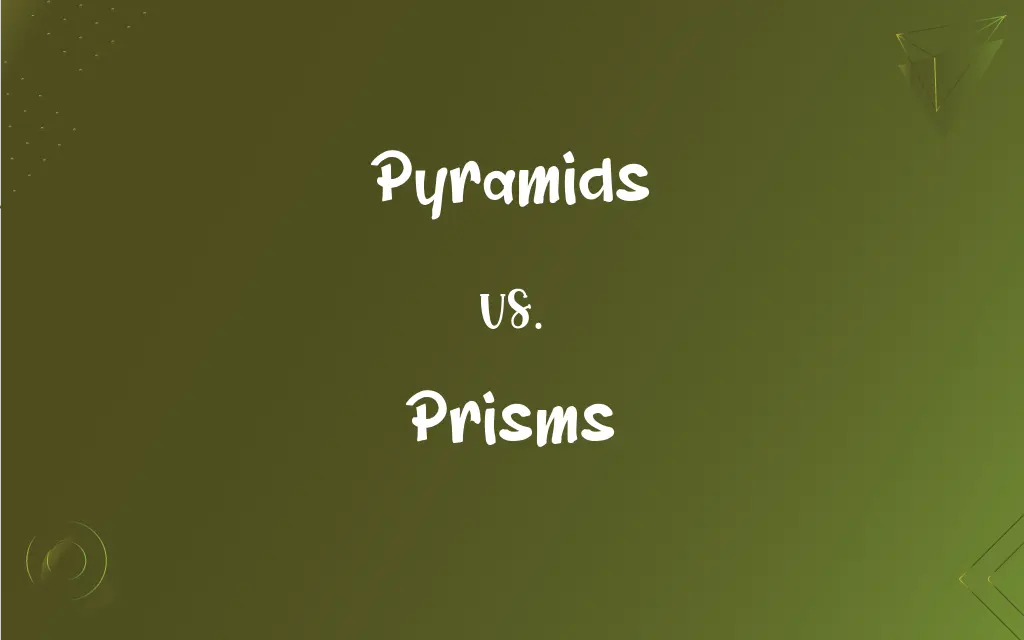Pyramids vs. Prisms: What's the Difference?
Edited by Janet White || By Harlon Moss || Updated on October 4, 2023
Pyramids have a polygon base and triangular sides that converge to a point; prisms have two parallel polygonal bases and rectangular or parallelogram sides.

Key Differences
Pyramids are three-dimensional geometric shapes characterized by a base that can be any polygon, and triangular sides that converge to a single point, known as the apex. Prisms, on the other hand, have two parallel bases that are congruent polygons, and their sides are rectangles or parallelograms.
In the world of geometry, pyramids are often associated with the iconic shape of the ancient Egyptian structures, but they can have any polygonal shape as their base, like triangle (tetrahedron), square, or pentagon. Prisms, in contrast, are more versatile in terms of base shapes; they can be rectangular, triangular, pentagonal, and so on, but they always maintain their depth consistently, unlike the tapering sides of pyramids.
Another defining characteristic of pyramids is that all its sides meet at the apex, giving it a pointed appearance. Prisms lack this apex; instead, they have a consistent cross-section throughout their length, which means if you cut a prism across its height, the shape you get would be the same as its base.
The volume of a pyramid is calculated as one-third the product of its base area and height. For prisms, the volume is the product of its base area and height. This highlights how the structures of pyramids and prisms impact their volumetric properties.
Finally, while both pyramids and prisms can stand tall and are integral parts of geometry, their structural differences define their uniqueness. Pyramids taper to a point, and prisms remain consistent in their depth, showcasing the beauty and diversity of geometric shapes.
ADVERTISEMENT
Comparison Chart
Base
Can be any polygon
Two parallel and congruent polygons
Faces/Sides
Triangular sides converging to an apex
Rectangular or parallelogram sides
Apex
Has one apex
Doesn't have an apex
Volume Formula
⅓ base area × height
Base area × height
Example Structures
Egyptian Pyramids, Tetrahedron
Glass prisms, Rectangular block
ADVERTISEMENT
Pyramids and Prisms Definitions
Pyramids
An ancient monumental structure with a square or triangular base and sloping sides.
The pyramids of Egypt were built as tombs for the pharaohs.
Prisms
A solid geometric figure with two congruent and parallel polygonal bases.
The children played with blocks shaped like rectangular prisms.
Pyramids
A polyhedron having a polygonal base and triangular faces.
The tetrahedron is a pyramid with a triangular base.
Prisms
Anything that separates light or other things into its constituent parts.
The rain acted as tiny prisms, creating a rainbow in the sky.
Pyramids
A solid with a polygonal base and triangular sides that meet at a point.
The Great Pyramid of Giza is one of the most famous pyramids in the world.
Prisms
An optical element that refracts light.
Prisms are used in binoculars to invert and revert the image.
Pyramids
Anything that resembles the shape of a pyramid.
The food pyramid illustrates the recommended intake of different food groups.
Prisms
A polyhedron with two polygonal faces and one or more faces that are parallelograms.
Triangular prisms have two triangular bases and three rectangular sides.
Pyramids
A structure or shape that resembles such a monument.
The company's hierarchy was shaped like pyramids with the CEO at the top.
Prisms
A glass or other transparent object in prism form.
The crystal prisms in the chandelier refracted the light into beautiful rainbows.
Pyramids
A solid figure with a polygonal base and triangular faces that meet at a common point.
Prisms
A solid figure whose bases or ends have the same size and shape and are parallel to one another, and each of whose sides is a parallelogram.
Pyramids
Something shaped like this polyhedron.
Prisms
A transparent body of this form, often of glass and usually with triangular ends, used for separating white light passed through it into a spectrum or for reflecting beams of light.
Pyramids
A massive monument of ancient Egypt having a rectangular base and four triangular faces culminating in a single apex, built over or around a crypt or tomb.
Prisms
A cut-glass object, such as a pendant of a chandelier.
FAQs
What's the primary distinction between pyramids and prisms?
Pyramids have a polygon base and triangular sides that meet at an apex; prisms have two parallel polygonal bases with sides that are rectangles or parallelograms.
Can prisms be used in everyday applications?
Yes, prisms are used in eyeglasses, binoculars, and various optical devices.
Are all prisms three-dimensional?
Yes, prisms are three-dimensional geometric shapes.
Do prisms always have a rectangular shape?
No, prisms can have bases that are triangles, pentagons, and other polygons.
Can a tetrahedron be considered a pyramid?
Yes, a tetrahedron is a pyramid with a triangular base.
Can pyramids have a base other than a triangle?
Yes, pyramids can have any polygonal base like square, pentagon, etc.
How do pyramids and prisms differ in their cross-sections?
Pyramids taper to an apex, while prisms have consistent cross-sections matching their bases.
What's the top point of a pyramid called?
The top point of a pyramid is called the apex.
What makes pyramids unique in architecture?
Pyramids have a wide base that narrows to an apex, providing stability and prominence.
Are all sides of a pyramid triangles?
Yes, the lateral sides of pyramids are always triangles.
Do prisms always have flat faces?
Yes, prisms have flat polygonal faces and sides that are rectangles or parallelograms.
Can a prism have a hexagonal base?
Yes, a prism can have any polygonal shape as its base, including hexagonal.
Are the triangular sides of pyramids always equal?
Not necessarily, they can be different depending on the pyramid's base shape and apex position.
How is the volume of a pyramid different from that of a prism?
Pyramid's volume is ⅓ of the base area times the height, while a prism's volume is the base area times the height.
What are the faces of a rectangular prism called?
The faces are called the base, top, and the four lateral or side faces.
Are prisms always transparent?
No, prisms in geometry can be solid; in optics, they're typically transparent.
Why are prisms used in periscopes?
Prisms are used to reflect and redirect light, allowing one to see over or around obstacles.
Is the Great Pyramid of Giza a geometric pyramid?
Yes, the Great Pyramid of Giza is a square pyramid.
What's the purpose of prisms in optics?
Prisms in optics refract and disperse light, separating it into its constituent colors.
Are the ancient Egyptian pyramids the only examples of pyramids?
No, pyramids exist in various cultures, but Egyptian ones are the most renowned.
About Author
Written by
Harlon MossHarlon is a seasoned quality moderator and accomplished content writer for Difference Wiki. An alumnus of the prestigious University of California, he earned his degree in Computer Science. Leveraging his academic background, Harlon brings a meticulous and informed perspective to his work, ensuring content accuracy and excellence.
Edited by
Janet WhiteJanet White has been an esteemed writer and blogger for Difference Wiki. Holding a Master's degree in Science and Medical Journalism from the prestigious Boston University, she has consistently demonstrated her expertise and passion for her field. When she's not immersed in her work, Janet relishes her time exercising, delving into a good book, and cherishing moments with friends and family.
































































